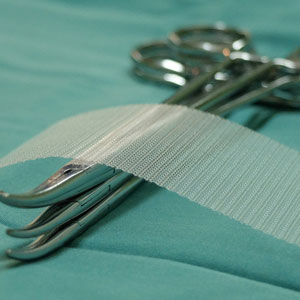5 Possible Complications After A Hernia Mesh Repair
 A report published in the British Medical Journal last year found that up to 170,000 patients could be experiencing hernia mesh complications from an operation within the last six years. Leading surgeons say the complication rate could be 12 to 30 percent of the 570,000 hernia mesh repairs performed in England. Here in America, similar reports are surfacing about hernia mesh products, where 3,488 hernia mesh lawsuits are pending against Ethicon and Davol/C.R. Bard in federal Multi-District Litigation proceedings. Learn which serious complications are most common after hernia mesh repair.
A report published in the British Medical Journal last year found that up to 170,000 patients could be experiencing hernia mesh complications from an operation within the last six years. Leading surgeons say the complication rate could be 12 to 30 percent of the 570,000 hernia mesh repairs performed in England. Here in America, similar reports are surfacing about hernia mesh products, where 3,488 hernia mesh lawsuits are pending against Ethicon and Davol/C.R. Bard in federal Multi-District Litigation proceedings. Learn which serious complications are most common after hernia mesh repair.
Infections
According to studies, up to 8 percent of patients develop infection following hernia mesh repair. The risk of infection increases in patients with obesity, diabetes, or immunosuppression. Not surprisingly, the risk is also greater with open procedures than laparoscopic ones. Further, research showed a higher incidence of infection with multifilament polyester mesh, rather than knitted monofilament polypropylene, polytetrafluoroethylene, or woven polypropylene. Microporous mesh has been linked with higher risk of infection than microporous mesh, though the latter has been linked with higher risk of adhesion and erosion.
Infections tended to surface two weeks to 39 months after the hernia repair, with symptoms like pain, skin redness (erythema), tenderness, swelling, and increased abdominal wall temperature. Some patients came down with fever, malaise, chills, or shakes. A mesh-related infection may result in a discharging fistula, intra-abdominal abscess, or osteomyelitis.
Adhesions
Adhesions refer to scar tissue between two surfaces in the human body. The body may form an adhesion following traumatic injury or it may develop in response to the insertion of a foreign body like hernia mesh.
Adhesions are believed to affect 67 to 93 percent of abdominal surgery patients. Sometimes the body repairs itself, but other times, the adhesion causes problems. One-third of patients with adhesions are admitted to the hospital for complications, and 1 in 20 patients undergo a secondary operation.
Hernia repair patients often suffer adhesions in the peritoneum — the membrane connecting the inner abdomen to the outer organs. Adhesions can cause a cascade of undesirable complications, including bowel obstruction, chronic abdominal and pelvic pain, infertility, painful urination, bloating, vomiting, and blocked digestion. This type of complication is extremely difficult to detect in physical examinations or with imaging technology like MRIs, and are usually found through laparoscopy while treating other comorbidities.
Hernia Recurrence
While the hernia recurrence rate with a mesh repair is lower than with a non-mesh repair, it can still happen. One study found the cumulative risk of reoperation for hernia recurrence was 17.1% in non-mesh surgeries, 12.3% in open mesh surgeries, and 10.6% in laparoscopic mesh repairs. The recurrence rate is higher among patients who are obese, malnourished, diabetic, anemic, jaundiced, smokers, heavy lifters, or taking steroids.
Bowel Obstruction
Hernias themselves are the second-highest cause of bowel obstructions, but even the repair can lead to adhesions that block the bowels as well. Adhesions are, in fact, the leading cause of bowel obstruction in America. Recalled mesh products were the main cause of bowel perforation and obstruction in the FDA’s analysis of medical adverse event reports.
Symptoms of a small-bowel obstruction include cramping, nausea, vomiting, inability to pass gas, bloating, and waves of abdominal pain that last five to 15 minutes. Symptoms of a large-bowel blockage include diarrhea or constipation, too.
If left untreated, a bowel obstruction can cut off blood supply to the intestines, causing the intestinal wall to die, tear, and develop a life-threatening infection known as septic shock. Treatment will require surgery to remove the mesh, adhesion, and damaged tissue.
Mesh Migration
According to literature, composite dual polypropylene meshes were most likely to migrate. Cases occur due to inadequate fixation of the mesh to the fascia or from an inflammatory reaction to the mesh over a period of years. It could take 5 to 30 years for mesh to degenerate to the point of migration. This type of complication is difficult to routinely diagnose with the help of ultrasound or CT technology; most patients need a colonoscopy to find mesh that has migrated to the colon.
Mesh migration is among the rarest complications of hernia repair, but it can cause some of the most serious side effects. Mesh erosion and migration may present as acute intestinal obstruction, mass formation, chronic abdominal pain, and bowel perforation.
Are You Suffering Hernia Mesh Repair Complications?
If you are suffering from any of these complications, you may be entitled to file a hernia mesh lawsuit seeking damages. Many types of hernia mesh have been recalled and are no longer on the market. Contact Chaffin Luhana for answers to questions about your hernia operation. We’ll get to the bottom of what happened – at no upfront cost to you. Get started with a free, no-obligation case review from a personal injury attorney.
